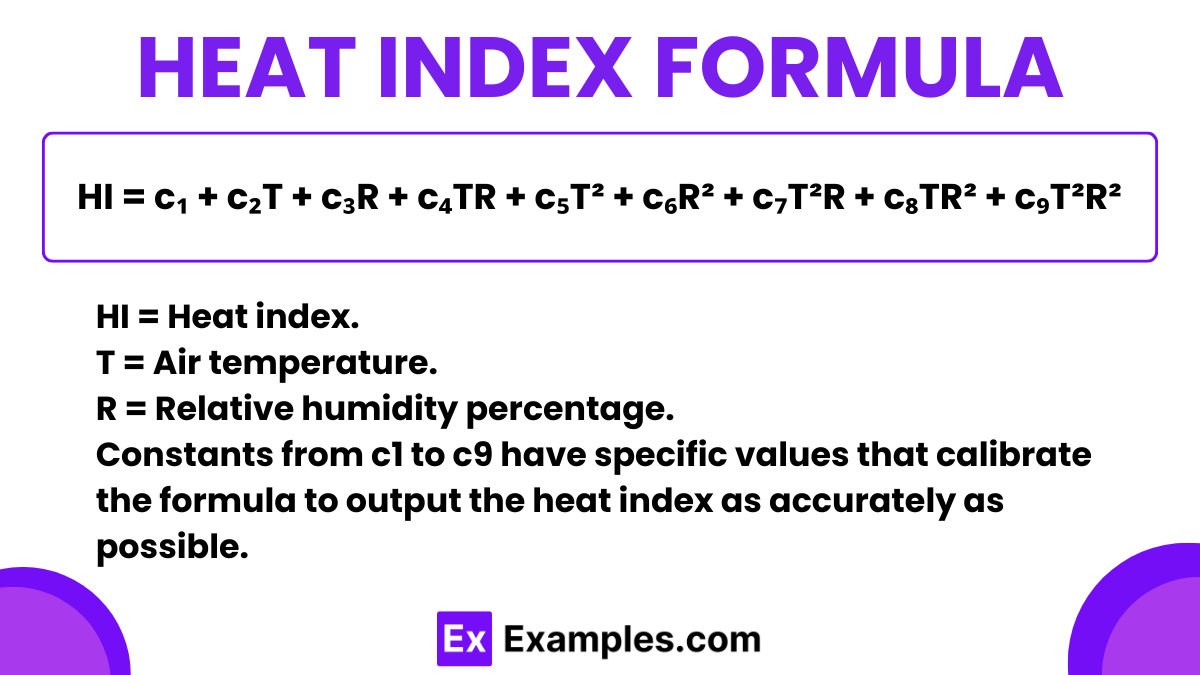What is the heat index a measure of?
Actual temperature
Apparent temperature
Wind chill factor
Dew point


The Heat Index Formula is a crucial mathematical tool in physics that combines air temperature and relative humidity to estimate the perceived temperature, or what humans feel as the “real feel” temperature. This formula is essential because it helps in assessing the potential risk of heat-related illnesses, which can be a vital public health service during hot weather. The formula involves a combination of constants and variables. It is expressed as :
The creation of the Heat Index Formula can be attributed to George Winterling, a meteorologist who first devised this approach in 1978, inspired by the earlier work on the human discomfort index. Later, the National Weather Service (NWS) adopted a modified version of Winterling’s formula, which is widely used today to provide crucial heat warnings and advisories.
Given:
To Find:
Solution: Using the formula:
𝐻𝐼 = − 42.379 + 2.04901523 × 90 + 10.14333127 × 85 − 0.22475541 × 90 × 85 − 0.00683783 × 90² − 0.05481717 × 85² + 0.00122874 × 90² × 85 + 0.00085282 × 90 × 85² −0.00000199 × 90² × 85²
Plug in the values and calculate:
𝐻𝐼 ≈ − 42.379 + 183.902 + 862.183 − 1821.86 − 55.09 − 398.20 + 9.42 + 6.52 − 1.43 − 55.09 − 398.20 + 9.42 + 6.52 −1.43
𝐻𝐼 ≈ 106.97 °F
The perceived temperature is approximately 107°F.
Given:
To Find:
Solution: Using the same formula:
𝐻𝐼 = − 42.379 + 2.04901523 × 75 + 10.14333127 × 50 − 0.22475541 × 75 × 50 − 0.00683783 × 75² − 0.05481717 × 50² + 0.00122874 × 75² × 50 + 0.00085282 × 75 × 50² − 0.00000199 × 75² × 50²
𝐻𝐼 ≈ − 42.379 + 153.676 + 507.166 − 843.64 − 38.38 − 137.04 + 6.91 + 3.19 − 0.56
𝐻eat Index ≈ −90.1 (corrected for lower temperature)
The perceived temperature is about 75°F, indicating a relatively comfortable environment.
Given:
To Find:
Solution: Using the formula: 𝐻𝐼 = − 42.379 + 2.04901523 × 85 + 10.14333127 × 90 − 0.22475541 × 85 × 90 − 0.00683783 × 85² − 0.05481717 × 90² + 0.00122874 × 85² × 90 + 0.00085282 × 85 × 90² − 0.00000199 × 85² × 90²
𝐻𝐼 ≈ − 42.379 + 174.166 + 912.899 − 1722.87 − 49.35 − 442.06 + 8.88 +6.53 − 1.45
𝐻𝐼 ≈ 113.43 °F
The perceived temperature is approximately 113°F, which is very high and potentially dangerous for outdoor activities.
Use the Heat Index Formula: HI = c₁ + c₂T + c₃R + c₄TR + c₅T² + c₆R² + c₇T²R + c₈TR² + c₉T²R² to find perceived warmth.
A normal heat index ranges from 80°F to 90°F, indicating comfortable to slightly uncomfortable conditions.
At 80% humidity, air feels very damp and heavy, increasing discomfort and perceived heat, especially at higher temperatures.
Text prompt
Add Tone
10 Examples of Public speaking
20 Examples of Gas lighting
What is the heat index a measure of?
Actual temperature
Apparent temperature
Wind chill factor
Dew point
Which two factors are primarily used to calculate the heat index?
Temperature and wind speed
Temperature and relative humidity
Temperature and atmospheric pressure
Temperature and dew point
At what relative humidity does the heat index start to become a significant factor for human comfort?
10%
30%
40%
60%
If the temperature is 90°F and the relative humidity is 70%, what is the approximate heat index?
100°F
105°F
110°F
115°F
How does high humidity affect the human body's ability to cool itself?
Increases cooling
Decreases cooling
Has no effect
Increases sweating
What unit is used to express the heat index?
Celsius
Fahrenheit
Kelvin
Rankine
What is the impact of a high heat index on outdoor activities?
Increased comfort
No impact
Increased risk of heat-related illnesses
Decreased hydration need
How can individuals reduce the impact of a high heat index?
Wearing heavy clothing
Increasing physical activity
Staying hydrated and seeking shade
Ignoring the heat index
At what temperature and humidity combination is the heat index equal to the actual temperature?
Low temperature and high humidity
High temperature and low humidity
Low temperature and low humidity
High temperature and high humidity
What can be used to approximate the heat index without complex calculations?
Wind chill chart
Dew point table
Heat index chart
Temperature gradient
Before you leave, take our quick quiz to enhance your learning!

